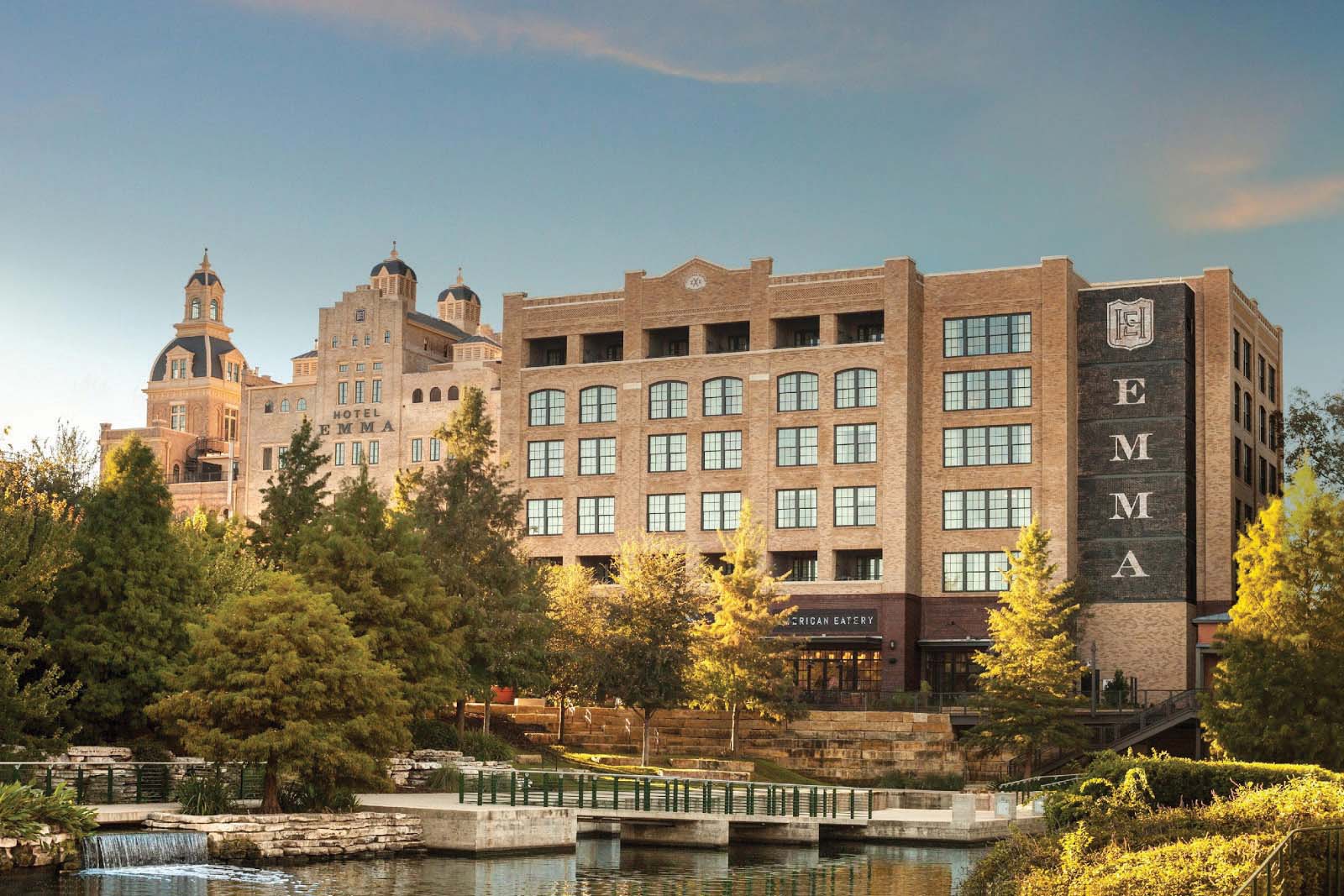
06 Sep Western Landmark: The Hotel Emma: San Antonio’s Living Landmark
If a city could hold its stories in four walls — memorializing its glory days, bridging its hard knocks with promises for the future — San Antonio could live within the Hotel Emma. Once a brewery but always a landmark, Texas’ only AAA five-diamond hotel blends the past and future, industrial chic with modern luxury, and incorporates design elements that reflect the influence of its German, Texan, Native American, and Mexican cultures.

Hotel Emma is set just steps from San Antonio’s famed Riverwalk, which wends through the city.
Stepping foot into the Hotel Emma — set riverside in San Antonio’s vibrant culinary and cultural village known as the Pearl District — one feels the immediate presence of the past. The air smells faintly of cedarwood, tobacco, and leather. Underfoot, brightly colored Redondo tiles pronounce the footsteps across them. Woods in every shade abound, from reclaimed sinker cypress and teak to mahogany; and exposed brick and weathered concrete compose the walls. Edison light bulbs cast a warm glow. Most striking of all, however, are the industrial remnants of the building’s brewing history — ammonia compressors and accumulators, fermenting tanks, brew kettles, giant window fans that look as if they could be propellers on a ship — like the sun-bleached bones of an animal, picked clean and arresting in their beauty.
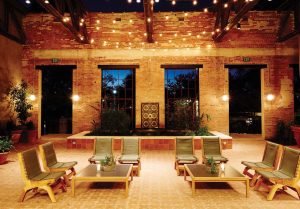
The hotel provides countless outdoor living spaces, including elegant patios where weddings are often held.
Guests’ interaction with the stories of this building and its long-ago inhabitants involves more than looking, more than imagining what once was. From check-in, they’re ushered into an airy two-story library where they’re offered a choice of cocktails in a hand-etched azure glass: La Babia margarita, named for the hotel owner’s Mexican ranch, or The Three Emmas — a stout concoction of Pearl beer, rose cordial, amontillado sherry, The Botanist gin, and grapefruit and lemon juices — named for the resolute women whose legacies live in the walls of the hotel. In every detail, the hotel pays tribute to the past.
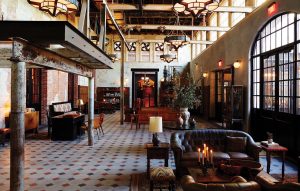
Hotel Emma’s lobby celebrates the brewery’s industrial artifacts, from cast-iron hoppers and a turn-of-the-century compressor to solid bronze hardware.
Once the headquarters for the Pearl Brewing Company, the Second Empire-style building was completed in 1894 under Chicago architect August Maritzen, who designed more than 85 breweries worldwide. Under proprietor Otto Koehler, an immigrant from Germany and a protégé of Adolphus Busch of the Anheuser-Busch dynasty, the Pearl became the largest brewery south of St. Louis.

The hotel’s rooftop pool is a wonderful place to while away an afternoon, lounging and noshing on poolside provisions and sophisticated cocktails. Photos courtesy of Hotel Emma
When Koehler’s wife Emma was injured in a car accident, Otto hired Emma Dumke to be her caregiver, and then she became his paramour. Dumke eventually fell in love with someone else, and Otto Koehler hired the third Emma — Emma Hedda Burgemeister — to replace Dumke as Emma Koehler’s nurse, and then she too became the object of his affection. In the end, the second and third Emmas were arrested for the murder of Otto Koehler. Emma Dumke was promptly released, and, after some drama, Emma Burgemeister was acquitted in 1918.
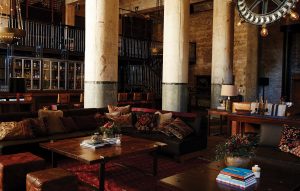
Inside the hotel’s Sterneworth bar, a dramatic 25-foot vaulted ceiling soars over intimate groupings of sofas, easy chairs, and banquettes.
Emma Koehler’s grit emerged when, after her husband’s death in 1914, she took over brewery operations, ushering the business through World War I and, even more incredibly, Prohibition and the Depression. Through wit and resolve, Emma managed to keep every last employee on the payroll by producing “near beer,” root beer, and ice cream. She even ran an auto repair shop and dry cleaner out of the building. Eventually, she handed the business over to her nephew in 1933 before her death in 1943. The brewery waxed and waned over the years, finally ceasing operations in 2001. The building was shuttered and eyed for a time as a distribution center for Walmart. Thankfully, fate had something better in store for the grand dame of San Antonio.

San Antonio’s Pearl District is a cultural and culinary mecca filled with chef-led restaurants, including a campus of the Culinary Institute of America, locally owned storefronts, and market vendors.
In 2002, Silver Ventures — a growth equity firm focused on food and the possibilities for meals to create culture, community, commerce, and yes, even joy, according to their mission statement — purchased the property and set about creating Hotel Emma. It took 13 years to transform the building into the luxurious 146-room boutique hotel it is today. New York-based architecture and design firm Roman and Williams undertook the massive project, careful at every turn to honor the past as it created old-world comfort in the context of the existing structure hidden beneath layers of dust.
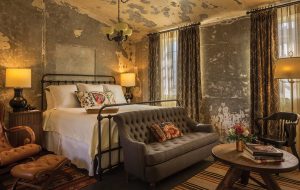
Hotel Emma offers a variety of room styles in its buildings, from top-floor suites in the original Brew House Tower to contemporary rooms in the River Cellars. Designers Roman and Williams made each room unique and luxurious, a blend of South Texas hospitality and old-world elegance.
Three towers define the hotel’s distinctive silhouette: the Brewhouse, with its iconic red brick exterior; the Cellars, recognizable by its contemporary glass façade; and the original 1894 tower, crowned with a copper cupola. All 146 rooms are unique, boasting cool concrete floors that contrast with warm wood furnishings. Some rooms feature exposed brick walls; others have floor-to-ceiling windows and terraces. The furnishings are a mix of vintage and custom-made pieces, creating romantic spaces that feel both timeless and thoroughly modern. The bathrooms, with gleaming white subway tiles and rain showerheads, offer a modern counterpoint.
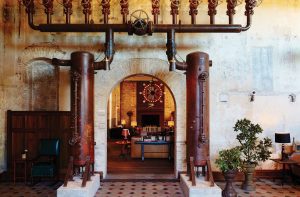
From the lobby, guests can admire the brick archways and window wells uncovered during renovation, alongside the brewery’s original ammonia manifold.
True to its mission, Silver Ventures created three distinct culinary experiences in the hotel. At Supper, the hotel’s American eatery, Chef Ned Elliot crafts dishes that reflect the seasons and the region. The menu changes frequently, but you might find yourself savoring a plate of Gulf shrimp with preserved lemon and chili oil or a hearty bowl of beef cheek pappardelle. For a more casual bite, Larder offers grab-and-go options in what was once the brewery’s provisions cellar. The shelves are stocked with house-made charcuterie, local cheeses, and fresh-baked breads. Don’t miss the signature lavender shortbread cookies made with herbs from the hotel’s on-site garden.
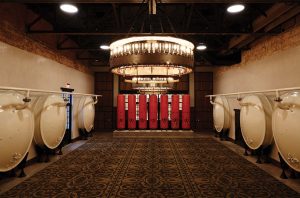
The hotel’s conference and banquet rooms are designed with artifacts from the brewery’s heyday. The Elephant Cellar, shown here, can seat 200. Photos courtesy of Hotel Emma
The 25-foot ceilings of the Sternewirth bar — named for the Sternewirth Privilege, which allowed brewery workers in the 19th century to drink free beer throughout the workday — use exposed brick walls to create a dramatic atmosphere, softened by the glow of copper light fixtures. Here, you can sip on a Pearl’s Old Fashioned, made with Ranger Creek Bourbon and bitters crafted in-house, while lounging in one of the repurposed fermentation tanks that serve as intimate seating areas.
The Hotel Emma doesn’t just preserve San Antonio’s brewing history. Indeed, it’s as if the hotel itself is a living, breathing entity. From miles away, visitors can still see the 1894 tower’s copper cupola, glowing like a signal fire, calling travelers home.
Carter Walker is a writer and editor living in Montana’s Horseshoe Hills. She is working on the 6th edition of her guidebook, Moon Montana & Wyoming, which will be released in spring 2025.






No Comments